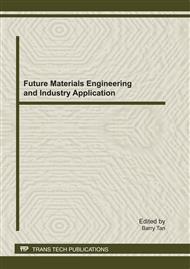[1]
P. Kaelina, L. Zauggb, A. M. Albertini, and F. Gadani, Activity of Bacillus thuringiensis isolates on Lasioderma serricorne (F. ) (Coleoptera: Anobiidae). J. Stored Prod. Res., 1999, vol. 35, p.145–158.
DOI: 10.1016/s0022-474x(98)00040-x
Google Scholar
[2]
S. C. Papadopoulou, and C.G. Athanassiou, Lariophagus distinguendus (F. ) (Hyme., Chalcidoidea, Pteromalidae), an ectoparasitoid of Lasioderma serricorne (F. ) (Col., Anobiidae), found for the first time in tobacco stores in Greece. J. Pest Sci., 2004, vol. 77, p.183.
DOI: 10.1007/s10340-004-0052-7
Google Scholar
[3]
E. Shaaya, M. Kostjukovski, J. Eilberg, and C. Sukprakarn, Plant oils as fumigants and contact insecticides for the control of stored-product insects. J. Stored Prod. Res., 1997, vol. 33, p.7–15.
DOI: 10.1016/s0022-474x(96)00032-x
Google Scholar
[4]
S. Kim, C. Park, M. H. Ohh, H. C. Cho, and Y. J. Ahn, Contact and fumigant activity of aromatic plant extracts and essential oils against Lasioderma serricorne (Coleoptera: Anobiidae). J. Stored Prod. Res., 2003, vol. 39, p.11–19.
DOI: 10.1016/s0022-474x(02)00013-9
Google Scholar
[5]
A. L. Tapondjoua, C. Adlerb, D. A. Fontemc, H. Boudaa, and C. Reichmuth, Bioactivity of cymol and essential oils of Cupressus sempervirens and Eucalyptus saligna against Sitophilus zeamais Motschulsky and Tribolium confusum du Val. J. Stored Prod. Res., 2005, vol. 41, p.91.
DOI: 10.1016/j.jspr.2004.01.004
Google Scholar
[6]
Z. L. Liu, S. H. Goh, and S. H. Ho, Screening of Chinese medicinal herbs for bioactivity against Sitophilus zeamais Motschulsky and Tribolium castaneum (Herbst). J. Stored Prod. Res., 2007, vol. 43, p.290–296.
DOI: 10.1016/j.jspr.2006.06.010
Google Scholar
[7]
M. B. Isman, Botanical insecticides: for richer, for poorer. Pest Manag. Sci., 2008, vol. 64, p.8–11.
DOI: 10.1002/ps.1470
Google Scholar
[8]
M. B. Isman, Botanical insecticides, deterrents, and repellents in modern agriculture and an increasingly regulated world. Annu. Rev. Entomol., 2006, vol. 51, p.45–66.
DOI: 10.1146/annurev.ento.51.110104.151146
Google Scholar
[9]
S. Rajendran, and V. Sriranjini, Plant products as fumigants for stored-product insect control. J. Stored Prod. Res., 2008, vol. 43, p.126–135.
DOI: 10.1016/j.jspr.2007.08.003
Google Scholar
[10]
R. Z. Yang, and C. S. Tang, Plants used for pest control in China: a literature review. Econ. Bot., 1988, vol. 42, p.376–406.
DOI: 10.1007/bf02860162
Google Scholar
[11]
F. S. Cheng, P. C. Dong, L. Jin, X. Zhang, T. J. Hu, F. Gao, and J. C. Meng, Determination and discussion of the trace elements in different parts of Ailanthus altissima. Studies of Trace Elements and Health., 2005, vol. 22, no. 5, p.23–24.
Google Scholar
[12]
W. S. Abbott, A method of computing the effectiveness of an insecticide. J. Econ. Entomol., 1925, vol. 18, p.265–267.
Google Scholar
[13]
SAS Institute, SAS/STAT User's Guide, Version 6. SAS Institute, Cary, North Carolina, (1994).
Google Scholar
[14]
C. Park, S. I. Kim, and Y. J. Ahn, Insecticidal activity of asarones identified in Acorus gramineus rhizome against three coleopteran stored-product insects. J. Stored Prod. Res., 2003, vol. 39, p.333–342.
DOI: 10.1016/s0022-474x(02)00027-9
Google Scholar
[15]
M. J. Pascual-Villalobos, and A. Robledo, Screening for anti-insect activity in Mediterranean plants. Ind. Crops Prod., 1998, vol. 8, no. 3, pp.183-194.
DOI: 10.1016/s0926-6690(98)00002-8
Google Scholar
[16]
R. M. Heisey, and T. K. Heisey, Herbicidal effects under field conditions of Ailanthus altissima bark extract, which contains ailanthone. Plant and Soil., 2003, vol. 256, p.85–99.
DOI: 10.1023/a:1026209614161
Google Scholar


